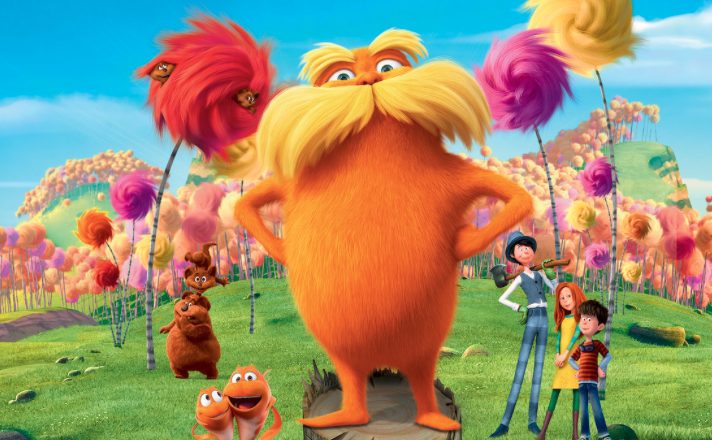Review: Environmental messages in ‘The Lorax’ inspire for the future
Photo credit: Netflix Promotional Poster for “The Lorax”
“The Lorax” is an activist-invoking tale ahead of it’s time. The Lorax is a film that has inspired audiences of all ages to take a stand against people and companies harming the environment.
April 12, 2021
Brightly colored wool-trees in a blossoming meadow, blooming flowers and fields of natural imagery are all staples throughout Universal Pictures’“The Lorax.” The utopic imagery of the fictional town of Thneedville depicts a world pre-environmental issues which contributes to the films underlying promotion of environmental activism and awareness.
“The Lorax” speaks to valuing morals and ethics over power and wealth. As a movie targeted towards children and families, the movie does a great job of communicating the importance of defending the environment from those who are driven only by profit incentives.
“The Lorax” was released on March 2, 2012, an adaptation of Dr Seuss’ book of the same name, and grossed over $348 million. The film features some big names in its cast such as Danny DeVito as the Lorax, Taylor Swift as Audrey, Zac Efron as Ted and Ed Helms as the Once-ler.
The film follows 12-year- old protagonist Ted Wiggins who lives in Thneedville, a completely artificial town without any plant-life, run by a corrupt “gazillionaire,” Aloysius O’Hare, voiced by Rob Riggle. When Ted’s love interest, Audrey, asks for a Truffula tree, he embarks on a mission to find a tree in hopes that he will gain Audrey’s respect. Advised by his grandmother, Ted visits the Once-ler outside Thneedville’s walls to gain intel. Through the Once-ler’s stories, an environmentalist within Ted is awoken.
“The Lorax” features 13 songs throughout its 86-minute run time, the most notable ones being: “Thneedville,”” This is the Place ,”” Everybody Needs a Thneed,” “How Bad Can I Be” and” Let It Grow.” The song titles seem to face their own story-arc that coincides with the plot. The songs depict the demise of the Lorax, along with the fall of the Once-ler’s morals.
Like most other film adaptations of books (“don’t trust a book by its movie”), “The Lorax” has faced criticism for its deviation from the book. A key difference is that the book has neither Ted, nor Audrey in it. While most movie adaptations include some sort of new character, many do not introduce an additional set of primary characters; in the case of the Lorax however, this worked out well.
In the absence of Ted and Audrey, “The Lorax” book follows the relationship between the Lorax, the Once-ler and the environment and has a more bitter tone to it. In fact, the Lorax was seen as bitter enough for it to be banned in a California school in 1989; the schools claimed that it promoted anti-deforestation beliefs in children. Without the ending-optimism, it made children uncomfortable rather than impassioned.
The Lorax explains issues without making them too complicated to understand, plus there is always something to learn from a re-watch. While tackling deforestation is an intimidating task, the impact that the two young characters have on their town is empowering to children who may be overwhelmed by the issues going on around them.
Like within the walls of Thneedville, we, too, are having conversations as a society about the environment and the climate crisis. As we learn more about the science that contributed to the issues within the environment, many people question decisions that have been made in the past and are looking for solutions.
Most of all, I appreciated The Lorax’s ending. A tree is planted in Thneedville, the evil billionaire gets what he deserved and it is all warm and sing-songy. However, what stood out from the cliched denouement was that the residents of Thneedville recognized the growth that they still needed to make. This connects to the goal, as a society, we need to be working towards. It is important to preserve the planet we live on: whether by reducing our carbon footprint or creating innovative solutions to the issue. “The Lorax” communicates that to its audience.
“The Lorax” was ahead of its time, and if you are not amongst the many who have done so, make it a point to watch it some time soon. And if you are a Lorax devotee like myself, I urge you to give it a good rewatch.
-
Story
-
Technical Quality
-
Enjoyment
-
Impact
Summary
“The Lorax” follows 12-year old Ted as he searches for a natural tree in an artificial town. Throughout the film Ted hears the story firsthand from the Once-ler, who caused the extinction of the Truffala Tree, of how Thneedville lost it’s once natural, vibrant environment. The Lorax is an impactful movie, as it puts environmental issues in more understandable terms, and motivates its audience. Despite the heavy topics and underlying messages within the movie, the Lorax manages to uphold an upbeat mood.









